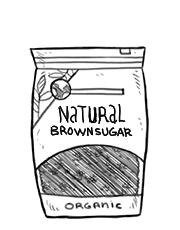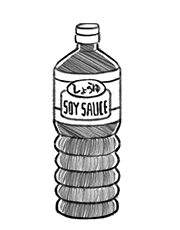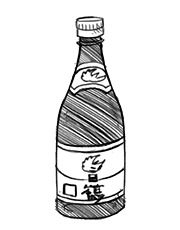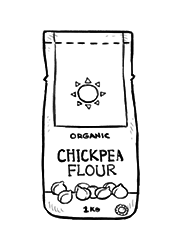sweet mock eel nigiri
2 servings — 50 minutes

Burmese tofu is made with chickpea flour, one of our staple foods. We first learned about this kind of tofu by reading The Burmese Kitchen by Aung Thein. The process for making this kind of tofu is usually much longer, if you're interested in making it the correct way the process is described at length on this page(which was copied digitally from The Burmese Kitchen). Our recipe suggests a quick way to make chickpea tofu, which was inspired by this recipe. It's a great soy-free alternative, and the texture is comparable to that of soft tofu.
Note: This recipe will use up about half of the burmese tofu, which means you'll have a whole other half to use in other meals.
We thought the chickpea tofu would be well-suited as a 'mock unagi kabayaki', and that it would look especially striking atop some black rice.
The sauce served over unagi (eel) kabayaki is sweet, with hints of caramel. Most Japanese sauces are easy to make, and usually require around 3-4 ingredients, these almost always include: soy sauce, sake, mirin, or Japanese rice vinegar. If you want to cook Japanese food, having these around is a must.
Besan flour. In this recipe I use chickpea flour, ground from whole dry chickpeas(garbanzo beans), besan/gram flour comes from ground brown chickpeas(sometimes peas too) and usually comes out finer, smoother when ground into flour. If using besan(gram) flour, remove 60 ml of water, or add 1/4 cup of flour. It's also possible to make chickpea tofu by soaking the beans, to blend them and to use that to make the batter(cooked, of course).
Thicker chickpea tofu.. If you prefer a firmer chickpea tofu, use 450 ml of vegetable broth instead of 500 ml.
Inorganic arsenic(iAs). Rice can be a significant source of iAs, especially brown rice because it is concentrated in the outer bran layer(bran is removed in white rice). Cooking the rice in excess water, say using a 1:6 rice to water ratio, reduces iAs up to 60 percent. [Source]. How to cook the rice?
Method 1: Boil 4 cups(1 cup of water for every cup of rice), add rice and boil for 5 minutes, discard the water, add 1 1/2 cups of fresh water back to the pot with the rice and bring to a boil, then lower to medium and cook until the water is absorbed.
Method 2: Regardless of the kind of rice you are cooking, bring a pot-full of water to a boil, add the rice and cook it like pasta(15 minutes boiling time for basmati), then drain the water out.
Note that soaking rice is also a good way to reduce iAs, but cooking the rice in excess water is a better approach.
 black glutinous rice140 g
black glutinous rice140 g japanese rice vinegar7 ml
japanese rice vinegar7 ml natural brown sugar15 g
natural brown sugar15 g nori sheets1 sheet
nori sheets1 sheet
rice
- Soak 140 g (~3/4 cup) of black glutinous rice overnight.
- Drain the rice. Add water to a pot, superimpose steam basket and add rice in it, cover with lid and steam for 40 min. After that time, pour 240 ml (~ 1 cup) of hot water over the rice. Shake the rice, and let it steam for another 10 min. Remove from heat, keep covered until serving time. To learn how to cook the rice to further reduce the amount of inorganic arsenic, see the notes above.
- Put 7 ml (1 1/2 tsp) of Japanese rice vinegar, 15 g (1 tbsp) of natural commercial brown sugar in a sauce pan. Stir over low heat, until sugar crystals dissolve. Let cool.
- Once rice is cooked, transfer to a flat tray, and pour sushi dressing over it. Mix dressing into rice with a spatula, using a sideways cutting motion. Cover with a damp towel, and let cool.
 soy sauce30 ml
soy sauce30 ml mirin30 ml
mirin30 ml natural brown sugar15 g
natural brown sugar15 g sake15 ml
sake15 ml
sauce
- Mix 30 ml (2 tbsp) of soy sauce, 30 ml (2 tbsp) of mirin, 15 g (1 tbsp) of natural commercial brown sugar and 15 ml (1 tbsp) of sake.
- Bring to a boil in a pan, lower heat and let thicken for a few minutes.
 vegetable bouillon500 ml
vegetable bouillon500 ml chickpea flour125 g
chickpea flour125 g salt1.25 g
salt1.25 g ground turmeric1.25 g
ground turmeric1.25 g
chickpea tofu
- Mix 125g (1 cup) of chickpea flour with 1.25 g (1/4 tsp) of salt, and 1.25 g (1/4 tsp) of ground turmeric. Stir in 250 ml (1 cup) of vegetable broth(or water) and stir until the mixture is lump-free, reserve mixture for later.
- Add the rest of the vegetable bouillon(250 ml| 1 cup) to a pot and bring to a rolling boil.
- Lower the heat to medium, pour in the chickpea flour mixture from the first step and whisk continuously for 5-10 minutes until the mixture has thickened.
- Pour into a 8x8 baking dish lined with a baking mat. Smooth out top with the back of a spoon.
- Let cool and set for 1 hour, then refrigerate(or let rest) for a little while longer before cutting, this will give the 'tofu' time to set.
- After 1 hour, cut into 12 pieces, and then cut in 2 again lengthwise to make them fit over nigiri.
- Preheat oven to 180 °C (350 °F).
- Line backing sheet with a baking mat, line up pieces of chickpea tofu.
- Bake for 15 minutes. Remove from oven, brush chickpea tofu with unagi sauce and bake for an additional 15 minutes.

- Shape tablespoons of black rice into oblongs, smear tops with a bit of wasabi, lay a nori strip texture-side up, place strip of chickpea tofu as well as the rice ball (wasabi side facing downwards) and finally fold nori over bottom of rice (cut off excess, you can wet the edges with a bit of water if ever it isn't sticking).
- Makes about 12 nigiri. If you have nigiri molds, shaping the rice into ovals will be very easy. Otherwise use your hands, keep them moist so the rice doesn't stick.
